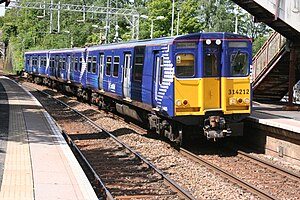
Back British Rail 314 sorozat Hungarian British Rail Class 314 Polish British Rail Class 314 SIMPLE 英國鐵路314型電力動車組 Chinese
| British Rail Class 314 | |
|---|---|
 First ScotRail Class 314 at Patterton in 2011 | |
 Interior of a ScotRail refurbished Class 314 unit in August 2018 | |
| In service | 1979–2019 |
| Manufacturer | British Rail Engineering Limited |
| Built at | Holgate Road Works, York |
| Family name | BREL 1972 |
| Constructed | 1979 |
| Entered service | 1979 |
| Refurbished |
|
| Scrapped | 2019–2020 |
| Number built | 16 |
| Number preserved | 1 (Converted into Class 614) |
| Number scrapped | 15 |
| Successor | |
| Formation | 3 cars per unit: DMSO-PTSO-DMSO |
| Diagram |
|
| Fleet numbers | 314201–314216 |
| Capacity | 212 seats |
| Operators | |
| Depots | |
| Lines served | |
| Specifications | |
| Car body construction | Steel underframe with aluminium body and roof |
| Car length |
|
| Width | 2.820 m (9 ft 3.0 in) |
| Height | 3.582 m (11 ft 9.0 in) |
| Floor height | 1.146 m (3 ft 9.1 in) |
| Doors | Double-leaf pocket sliding, each 1.288 m (4 ft 2.7 in) wide (2 per side per car) |
| Wheelbase | Over bogie centres: 14.170 m (46 ft 5.9 in) |
| Maximum speed | 70 mph (113 km/h) |
| Weight |
|
| Traction motors | |
| Power output | 660 kW (880 hp) |
| Electric system(s) | 25 kV 50 Hz AC overhead |
| Current collector(s) | Pantograph |
| UIC classification | Bo′Bo′+2′2′+Bo′Bo′ |
| Bogies | BREL BX1 |
| Minimum turning radius | 70.4 m (231 ft 0 in) |
| Braking system(s) | Electro-pneumatic (disc) |
| Safety system(s) | |
| Coupling system | Tightlock |
| Multiple working | Within class |
| Track gauge | 1,435 mm (4 ft 8+1⁄2 in) standard gauge |
| Notes/references | |
| Specifications as at August 1982[1] except where otherwise noted. | |
The British Rail Class 314 was a class of alternating current electric multiple unit (EMU) trains built by British Rail Engineering Limited's Holgate Road carriage works in 1979. They were a class of units derived from British Rail's 1971 prototype suburban EMU design which, as the BREL 1972 family, eventually encompassed 755 vehicles over five production classes (313, 314, 315, 507 and 508).[2]
The Class 314 fleet was used to operate inner-suburban services on the Strathclyde Partnership for Transport rail network in and around Glasgow, most typically on the Argyle, North Clyde, Cathcart Circle, Paisley Canal and Inverclyde lines. The units, formed of three cars each, worked either independently or in six-car pairs.
Although the fleet had undergone a number of life-extension overhauls and upgrades, it was withdrawn from service in 2018–2019 as a result of non-compliance with the requirements of the Persons with Reduced Mobility Technical Specification for Interoperability (PRM-TSI),[a] which became legally binding at the end of December 2019. It was replaced, for the most part, by cascaded Class 318 and Class 320 units following the introduction of the Class 385 fleet.
Following withdrawal, all but one unit was scrapped; the remaining unit has been converted to act as a technology demonstrator using hydrogen-powered fuel cells and was reclassified into Class 614 in October 2021.
- ^ Vehicle Diagram Book No. 210 for Electric Multiple Units (including A.P.T.) (PDF). Derby: Mechanical & Electrical Engineering Department, British Railways Board. August 1982. EA206, EH211 (in work pp. 14–15, 280–281). Archived from the original (PDF) on 21 January 2015. Retrieved 24 May 2023 – via Barrowmore MRG.
- ^ "The twilight zone". Railways Illustrated. No. 249. November 2023. pp. 50–53.
Cite error: There are <ref group=lower-alpha> tags or {{efn}} templates on this page, but the references will not show without a {{reflist|group=lower-alpha}} template or {{notelist}} template (see the help page).